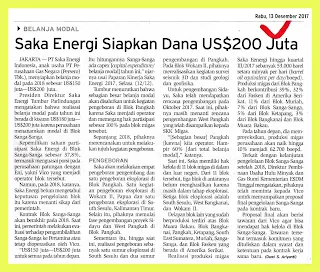PT Saka Energi Indonesia, a subsidiary of PT Perusahaan Gas Negara (PGN), recorded an increase in production this year by 53,000 barrels of oil per day (barels of oil per day / BOPD).
The increase in production is supported by the production contribution from Block Pangkah as the operator block off the east coast of Java Sea and non-operator block, among others, Muara Bakau Block (Jangkrik Field), Bangkanai Block (Central Kalimantan) Ketapang Block in the Java Sea.
Chief Executive Officer (CEO) of Saka Energi Indonesia Tumbur Parlindungan said, next year it is ready to spend USD 150 million to add new investment through the drilling of development wells and exploration wells.
"In 2018 we will drill seven wells consisting of 4 development wells and 3 exploration wells located in Pangkah Block, South Sesulit Block, and Woman II Block," he said.
Saka Energi will spend USD 10 million to USD 15 million per well. If totaled at planned wells, total investment reaches a total of US $ 150 million.
"Drilling per well is about USD 10 million to USD 15 million, there is another development of about USD 150 million," he said.
The largest investment is spent in Block Pangkah, where Saka Energy becomes the blocked operator.
"We drilled almost 60% as operators on the block. This block has the most expensive production costs or reach USD 8 to USD 9 dollars per barrel, "he said.
Tumbur also added, starting next year as part of the digital transformation, Saka Energy will implement the data security system. Use of the system is expected to avoid the threat of cyber attacks.
"With the use of this system, we expect increased productivity can also occur where all information from the work is placed on a systematic system and can be easily accessed through the application so that the decision-making can be done efficiently," he concluded.
As a subsidiary of PT PGN, Saka Energi focuses more on the exploration and production of upstream oil and gas. Currently PT Saka Energi manages the participating interest in 10 blocks in Indonesia, including 1 block of shale gas in Indonesia. Three of them are managed by Saka as an operator with 100% parcitipating interest in Pangkas Block, Sout Sesuku and Wokam II-Papua Block.
IN INDONESIA
Saka Energi Catat Produksi 53.000 BOPD
Anak usaha PT Perusahaan Gas Negara (PGN), PT Saka Energi Indonesia mencatat peningkatan produksi tahun ini sebesar 53.000 barrel minyak per hari (barels of oil per day/BOPD).
Peningkatan produksi tersebut didukung oleh sumbangan hasil produksi dari Blok Pangkah sebagai blok operator di lepas pantai bagian timur Laut Jawa serta blok-blok bukan operator (non-operator), di antaranya Blok Muara Bakau (Lapangan Jangkrik), Blok Bangkanai (Kalimantan Tengah), Blok Ketapang di Laut Jawa.
Chief EXecutive Officer (CEO) Saka Energi Indonesia Tumbur Parlindungan mengatakan, tahun depan pihaknya siap mengeluarkan dana sebesar USD 150 juta untuk menambah investasi baru melalui pengeboran sumur pengembangan maupun sumur eksplorasi.
”Pada 2018 kami akan melakukan pengeboran pada tujuh sumur terdiri atas 4 sumur pengembangan dan 3 sumur eksplorasi yang berada di Blok Pangkah, Blok South Sesulit, serta Blok Woman II,”katanya.
Saka Energi akan mangeluarkan dana USD 10 juta hingga USD 15 juta per sumur. Jika ditotal di sumur yang direncanakan, total investasi mencapai total US$ 150 juta.
"Drilling per well itu sekitar USD 10 juta hingga USD 15 juta. Ada lagi pengembangannya sekitar USD 150 jutaan,” ujarnya.
lnvestasi paling besar dikeluarkan di Blok Pangkah, di mana Saka Energi menjadi operator diblok tersebut.
”Kami mengebornya hampir 60% sebagai operator di blok itu. Blok ini memiliki biaya produksi paling mahal atau mencapai USD 8 sampai USD 9 dolar per barel,”ungkapnya.
Tumbur juga menambahkan, mulai tahun depan sebagai bagian dari transformasi digital, Saka Energi akan menerapkan penggunasan sistem sekuriti data. Penggunaan sistem tersebut diharapkan mampu menghindari adanya ancaman serangan siber.
”Dengan penggunaan sistem ini, kami berharap peningkatan produktivitas juga bisa terjadi di mana seluruh informasi dari pekerjaan ditempatkan pada sistem sistematis dan bisa mudah diakses melalui aplikasi sehingga pembuatan keputusan bisa terlaksana dengan efisien,” pungkasnya.
Sebagai anak usaha PT PGN, Saka Energi lebih fokus pada eksplorasi dan produksi hulu minyak dan gas bumi. Saat ini PT Saka Energi mengelola participating interest pada 10 blok di Indonesia, termasuk 1 blok shale gas di Indonesia. Tiga diantaranya dikelola Saka sebagai operator dengan kepemilikan 100% parcitipating interesting di Blok Pangkas, Sout Sesuku dan Blok Wokam ll- Papua.
Koran Sindo, Page-19, Wednesday, Dec 13, 2017













